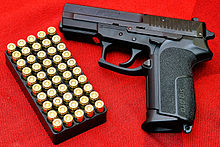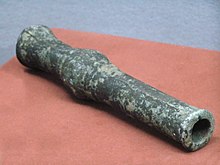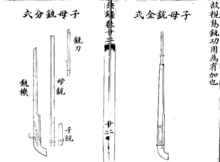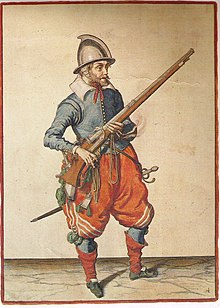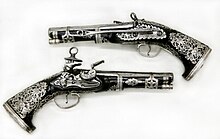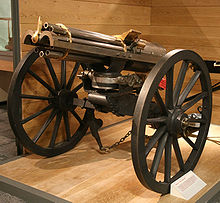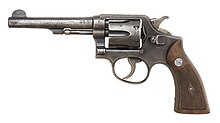A cannon is a large-caliber gun classified as a type of artillery, which usually launches a projectile using explosive chemical propellant. Gunpowder was the primary propellant before the invention of smokeless powder during the late 19th century. Cannons vary in gauge, effective range, mobility, rate of fire, angle of fire and firepower; different forms of cannon combine and balance these attributes in varying degrees, depending on their intended use on the battlefield. A cannon is a type of heavy artillery weapon.

A firearm is any type of gun that uses an explosive charge and is designed to be readily carried and used by an individual. The term is legally defined further in different countries.

Gunpowder, also commonly known as black powder to distinguish it from modern smokeless powder, is the earliest known chemical explosive. It consists of a mixture of sulfur, carbon, and potassium nitrate (saltpeter). The sulfur and carbon act as fuels while the saltpeter is an oxidizer. Gunpowder has been widely used as a propellant in firearms, artillery, rocketry, and pyrotechnics, including use as a blasting agent for explosives in quarrying, mining, building pipelines, tunnels, and roads.

An arquebus is a form of long gun that appeared in Europe and the Ottoman Empire during the 15th century. An infantryman armed with an arquebus is called an arquebusier.

A musket is a muzzle-loaded long gun that appeared as a smoothbore weapon in the early 16th century, at first as a heavier variant of the arquebus, capable of penetrating plate armour. By the mid-16th century, this type of musket gradually disappeared as the use of heavy armour declined, but musket continued as the generic term for smoothbore long guns until the mid-19th century. In turn, this style of musket was retired in the 19th century when rifled muskets using the Minié ball became common. The development of breech-loading firearms using self-contained cartridges and the first reliable repeating rifles produced by Winchester Repeating Arms Company in 1860 also led to their demise. By the time that repeating rifles became common, they were known as simply "rifles", ending the era of the musket.

A matchlock or firelock is a historical type of firearm wherein the gunpowder is ignited by a burning piece of flammable cord or twine that is in contact with the gunpowder through a mechanism that the musketeer activates by pulling a lever or trigger with their finger. This firing mechanism was an improvement over the hand cannon, which lacked a trigger and required the musketeer or an assistant to apply a match directly to the gunpowder by hand. The matchlock mechanism allowed the musketeer to apply the match himself without losing his concentration.

A gun barrel is a crucial part of gun-type weapons such as small firearms, artillery pieces, and air guns. It is the straight shooting tube, usually made of rigid high-strength metal, through which a contained rapid expansion of high-pressure gas(es) is used to propel a projectile out of the front end (muzzle) at a high velocity. The hollow interior of the barrel is called the bore, and the diameter of the bore is called its caliber, usually measured in inches or millimetres.

A ranged weapon is any weapon that can engage targets beyond hand-to-hand distance, i.e. at distances greater than the physical reach of the user holding the weapon itself. The act of using such a weapon is also known as shooting. It is sometimes also called projectile weapon or missile weapon because it typically works by launching solid projectiles ("missiles"), though technically a fluid-projector and a directed-energy weapon are also ranged weapons. In contrast, a weapon intended to be used in hand-to-hand combat is called a melee weapon.

The hand cannon, also known as the gonne or handgonne, is the first true firearm and the successor of the fire lance. It is the oldest type of small arms as well as the most mechanically simple form of metal barrel firearms. Unlike matchlock firearms it requires direct manual external ignition through a touch hole without any form of firing mechanism. It may also be considered a forerunner of the handgun. The hand cannon was widely used in China from the 13th century onward and later throughout Eurasia in the 14th century. In 15th century Europe, the hand cannon evolved to become the matchlock arquebus, which became the first firearm to have a trigger.
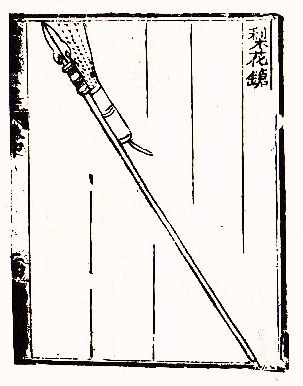
The fire lance was a gunpowder weapon and the ancestor of modern firearms. It first appeared in 10th–12th century China and was used to great effect during the Jin-Song Wars. It began as a small pyrotechnic device attached to a polearm weapon, used to gain a shock advantage at the start of a melee. As gunpowder improved, the explosive discharge was increased, and debris or pellets added, giving it some of the effects of a combination modern flamethrower and shotgun, but with a very short range, and only one shot. By the late 13th century, fire lance barrels had transitioned to metal material to better withstand the explosive blast, and the lance-point was discarded in favor of relying solely on the gunpowder blast. These became the first hand cannons.
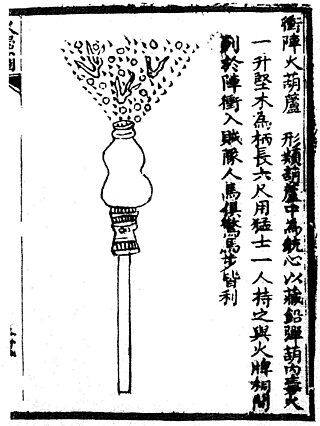
The history of firearms begins in 10th-century China, when tubes containing gunpowder and pellet projectiles were mounted on spears to make portable fire lances, operable by one person. This was later used effectively as a shock weapon in the Siege of De'an in 1132. In the 13th century, fire lance barrels were replaced with metal tubes and transformed into metal-barreled hand cannons. The technology gradually spread throughout Eurasia during the 14th century and evolved into flintlocks, blunderbusses, and other variants. The 19th and 20th centuries saw an acceleration in this evolution, with the introduction of the magazine, belt-fed weapons, metal cartridges, and the automatic firearm. Older firearms typically used black powder as a propellant, but modern firearms use smokeless powder or other propellants. Most modern firearms have rifled barrels.
The history of cannons spans several hundred years from the 12th century to modern times. The cannon first appeared in China sometime during the 12th and 13th centuries. It was most likely developed in parallel or as an evolution of an earlier gunpowder weapon called the fire lance. The result was a projectile weapon in the shape of a cylinder that fired projectiles using the explosive pressure of gunpowder. Cannons were used for warfare by the late 13th century in the Yuan dynasty and spread throughout Eurasia in the 14th century. During the Middle Ages, large and small cannons were developed for siege and field battles. The cannon replaced prior siege weapons such as the trebuchet. After the Middle Ages, most large cannons were abandoned in favor of greater numbers of lighter, more maneuverable field artillery. New defensive fortifications such as bastions and star forts were designed specifically to better withstand artillery sieges. Cannons transformed naval warfare with its deadly firepower, allowing vessels to destroy each other from long range. As rifling became more commonplace, the accuracy of the cannon was significantly improved, and they became deadlier than ever, especially to infantry. In World War I, a considerable majority of all deaths were caused by cannons; they were also used widely in World War II. Most modern cannons are similar to those used in the Second World War, including autocannons—with the exception of naval guns, which are now significantly smaller in caliber.

The Huolongjing, also known as Huoqitu, is a Chinese military treatise compiled and edited by Jiao Yu and Liu Bowen of the early Ming dynasty (1368–1683) during the 14th century. The Huolongjing is primarily based on the text known as Huolong Shenqi Tufa, which no longer exists.
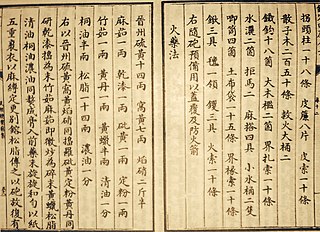
Gunpowder is the first explosive to have been developed. Popularly listed as one of the "Four Great Inventions" of China, it was invented during the late Tang dynasty while the earliest recorded chemical formula for gunpowder dates to the Song dynasty. Knowledge of gunpowder spread rapidly throughout Asia and Europe, possibly as a result of the Mongol conquests during the 13th century, with written formulas for it appearing in the Middle East between 1240 and 1280 in a treatise by Hasan al-Rammah, and in Europe by 1267 in the Opus Majus by Roger Bacon. It was employed in warfare to some effect from at least the 10th century in weapons such as fire arrows, bombs, and the fire lance before the appearance of the gun in the 13th century. While the fire lance was eventually supplanted by the gun, other gunpowder weapons such as rockets and fire arrows continued to see use in China, Korea, India, and this eventually led to its use in the Middle East, Europe, and Africa. Bombs too never ceased to develop and continued to progress into the modern day as grenades, mines, and other explosive implements. Gunpowder has also been used for non-military purposes such as fireworks for entertainment, or in explosives for mining and tunneling.

The gunpowder empires, or Islamic gunpowder empires, is a collective term coined by Marshall G. S. Hodgson and William H. McNeill at the University of Chicago, referring to three early modern Muslim empires: the Ottoman Empire, Safavid Empire and the Mughal Empire, in the period they flourished from mid-16th to the early 18th century. These three empires were among the most stable empires of the early modern period, leading to commercial expansion, and patronage of culture, while their political and legal institutions were consolidated with an increasing degree of centralization. They stretched from Central Europe and North Africa in the west to Bengal and Arakan in the east. Hodgson's colleague William H. McNeill expanded on the history of gunpowder use across multiple civilizations including East Asian, South Asian and European powers in his "The Age of Gunpowder Empires". Vast amounts of territory were conquered by the gunpowder empires with the use and development of the newly invented firearms, especially cannon and small arms, in the course of imperial expansion. Like in Europe, the introduction of gunpowder weapons prompted changes such as the rise of centralized monarchical states.
Gunpowder weapons in the Song dynasty included fire arrows, gunpowder lit flamethrowers, soft shell bombs, hard shell iron bombs, fire lances, and possibly early cannons known as "eruptors". The eruptors, such as the "multiple bullets magazine eruptors", consisting of a tube of bronze or cast iron that was filled with about 100 lead balls, and the "flying-cloud thunderclap eruptor", were early cast-iron proto-cannons that did not include single shots that occluded the barrel. The use of proto-cannon, and other gunpowder weapons, enabled the Song dynasty to ward off its generally militarily superior enemies—the Khitan led Liao, Tangut led Western Xia, and Jurchen led Jin—until its final collapse under the onslaught of the Mongol forces of Kublai Khan and his Yuan dynasty in the late 13th century.

The Heilongjiang hand cannon or hand-gun is a bronze hand cannon manufactured no later than 1288 and is the world's oldest confirmed surviving firearm. It weighs 3.55 kg and is 34 centimeters long. The Heilongjiang hand cannon was excavated during the 1970s in Banlachengzi, a village in Acheng District, Heilongjiang province, China. It was found alongside other bronze artifacts made in the style of the Jurchen Jin Dynasty. The hand cannon was probably used in battles fought nearby in Banlachengzi in 1287 and 1288. The History of Yuan states that a Jurchen commander by the name of Li Ting led a group of soldiers equipped with hand cannons into a military camp in 1288, as part of an anti-rebellion campaign for the Yuan dynasty. The cannon currently resides at the Heilongjiang Provincial Museum in Harbin, China.
This is a timeline of the history of gunpowder and related topics such as weapons, warfare, and industrial applications. The timeline covers the history of gunpowder from the first hints of its origin as a Taoist alchemical product in China until its replacement by smokeless powder in the late 19th century.
Cetbang were cannons produced and used by the Majapahit Empire (1293–1527) and other kingdoms in the Indonesian archipelago. There are 2 main types of cetbang: the eastern-style cetbang which looks like a Chinese cannon and is loaded from the front, and the western-style cetbang which is shaped like a Turkish and Portuguese cannon, loaded from the back.
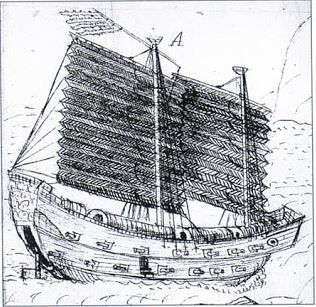
The Ming dynasty continued to improve on gunpowder weapons from the Yuan and Song dynasties as part of its military. During the early Ming period larger and more cannons were used in warfare. In the early 16th century Turkish and Portuguese breech-loading swivel guns and matchlock firearms were incorporated into the Ming arsenal. In the 17th century Dutch culverin were incorporated as well and became known as hongyipao. At the very end of the Ming dynasty, around 1642, Chinese combined European cannon designs with indigenous casting methods to create composite metal cannons that exemplified the best attributes of both iron and bronze cannons. While firearms never completely displaced the bow and arrow, by the end of the 16th century more firearms than bows were being ordered for production by the government, and no crossbows were mentioned at all.
